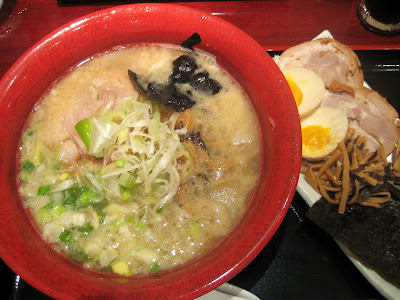 Can you guess where are they from?
Can you guess where are they from?Thursday, December 30, 2010
2010 Ramen Trend
 Can you guess where are they from?
Can you guess where are they from?Friday, December 24, 2010
White Miso Ramen - Kura (久楽) Plaza Singapura

Address: #04-01 Plaza Singapura
Types: Miso
Price: S$12.8
Rating: 6.5/10
Monday, December 6, 2010
Ramen in Jakarta! Marutama Ramen - eX Plaza Indonesia
 the orange basketball...
the orange basketball...Sunday, November 7, 2010
Keisuke Premium Tonkotsu Ramen @ Keisuke Tokyo
 left - in March, right - in October
left - in March, right - in OctoberSunday, October 31, 2010
New Menu at Sapporo Ramen Miharu - Tori-dashi Ramen
Miharu is known for ramen with rich miso-based broth, so it is interesting that it has created a light ramen on it repertoire. It might be a coincidence that signature dish of the most popular ramen store (by my research), Marutama, is also chicken-based. The ramen scene in Singapore is getting more competitive with many new entrants, so long-established incumbents like Miharu has to adapt too.
Back to the ramen... of course I ordered the new item to try it out.

The first thing that jumped out of this ramen is the generous topping of spring onion. The green spring onion took up almost half of the bowl. The clear chicken stock was layered with sesame, adding a flagrant smell to the ramen. It was also topped with a portion of menma, seaweed and 3 flavoured quail eggs. Interesting - it is the first time in Singapore that I saw quail eggs being used in ramen.

Monday, October 4, 2010
2010 Q3 Unofficial Ramen Ranking Results!
Saturday, September 11, 2010
Ippudo TAO @ UE Square - TAO Kuro

Address: 207 River Valley Road #0-55-56, UE Square
Types: Tonkotsu
Sunday, August 1, 2010
Making Ajitama (味玉)
Thursday, July 29, 2010
Ramen ranks No. 2 in the ranking for the most loved Japanese food by tourists!
Monday, July 26, 2010
Crab Ramen - Keisuke Tokyo (けいすけ東京)


All in all, its another good bowl of ramen. It will be suitable for those who likes it rich and thick.
Sunday, July 11, 2010
Kusabi (くさび) - Tokumaru Shoyu Tonkotsu Ramen
 ... taking over Kyoto Sabo’s space
... taking over Kyoto Sabo’s spaceAddress: 6 Eu Tong Seng Street, #01-68/69, The Central @ Clarke Quay
Types: Tonkotsu
Price: S$13.5 - S$19
Rating: 8/10
Sunday, July 4, 2010
Ramen Walker Feature @ WAttention
Ramen Walker has done a ramen feature for the latest edition of the free magazine WAttention, which was released today!
 The 4th item on the front page, "Slurping Life" :)
The 4th item on the front page, "Slurping Life" :)WAttention, a word made from combining "Wa" (= 和, meaning things that are Japanese) and "Attention", is a free magazine that talks about Japanese culture and traditions to the Singapore audience. I was fortunate enough to be contacted by WAttention a few months ago to have me as the guest writer for a feature of 13 ramen places in Singapore. The shops selected by WAttention covers most of the prominent ramen places in town.
 Featuring places such as Shinchan, Keisuke, Tampopo, etc
Featuring places such as Shinchan, Keisuke, Tampopo, etcAs it is a good opportunity to share with more people about ramen, I took it up, ate my way through many ramen places, and recently completed the feature!
There are limited spaces that I could write for each shop so the description may not be that detailed, but it was fun finding out about the ramen store, speaking to some of the owners, and penning down my observations. For example, I managed to speak to Mr Tajima, the owner of Menya Shinchan, that I wrote about in a previous blog entry, and Mr Tsutsumi, the franchise manager for Sanomaru, who shared with me his challenge during the set-up stage. These encounters would not have been possible if not for this opportunity.
Anyway, an interesting assignment that helped me discover more interesting facts about the Singapore ramen scene. And it is exciting to see it coming out in hardcopy too!
Last but not least....
Grab one copy of WAttention!!
Wednesday, June 30, 2010
2010 1H Unofficial Ramen Ranking
Sunday, June 27, 2010
Menya Shinchan - Tonkotsu Seafood Tsuke-men & In Conversation with Tajima-san







































